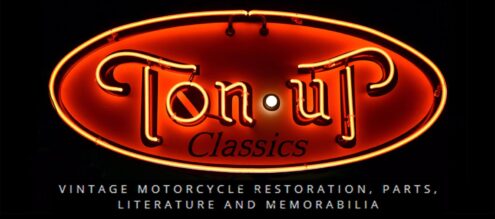Featured here is a very rare motorcycle, a 1964 Triumph T120C Competition Sports Scrambler. One of only 60 manufactured during the ’64 season. This was an east coast model supplied mostly to Tri-cor in Baltimore. Johnson Motors on the west coast took delivery of 412 T120C T.T. Specials which were out and out stripped down racers with no lighting. It was discovered in the factory engine records comments that this T120C was logged as being built with a l/o alternator and 18t gearbox sprocket (the TT variants were recorded as T120C ET and 17t gearbox sprocket). It was assembled on June 15th 1964 and dispatched to Tri Corp on June 19th 1964. My thanks go out to Charles Rising for providing me with this information.
The restoration was a back burner job that was completed over a 3 year span during covid. Most of that time was completing the dry build, there were quite a few hard to find one year only parts to locate which took time. It started as a basket case that included matching frame and engine cases as well as a couple of boxes of miscellaneous parts. I had my work cut out completing this job using for the most part oem factory parts only but the end results are very pleasing. I decided to powder coat the Frame and a selection of cycle parts opting to wet paint the more important parts. These included the oil tank, side panel, chainguard, headlamp mounts, fork sliders etc. Boxes of parts went out to the chrome shop, polisher and cad plater after which final assembly could begin.
Designated colors for the 1964 Bonneville models were gold and white. Paint was supplied by Don Hutchinson and was applied by the talented Geoff Giamarco at Heritage Motorcycles. Polished Alloy fenders with beaded edges were fitted to some of the 60 T120C’s produced although most came with painted guards. There was a factory bulletin outlining the availability of the alloy fenders and internal fork damper units fitted to all C Models across the range and the price increase for such items. The alloy guard are both factory items, not reproduction. All cycle parts were finished in gloss black.
The seat covers on the competition models were all black. No white piping or logo on the back of the seat as this was not introduced until 1966. R.K Leighton in the UK supplied the seat cover. A very nice replica of the original grain the factory used back in the day. The foam was sourced for a local supplier and I am well happy how the finished seat came out. I am very fussy when it comes to the seats on restored bikes as I feel that the seat often spoils the factory lines if not correct. Also I try my very hardest to get things spot on when it comes to hardware, no hardware store stuff here. All hardware is cleaned inspected, dressed or replaced before cad plating. Luckily I have a large selection of original nuts and bolts etc to go to when in need.
The engine was completely overhauled from the crankshaft up. I purchased a replacement Crank which had standard journals that polished up very nicely. Thanks go out to Dan over at Franz and Grubb who took care of the Cylinder Bore, Head and Rods. Great attention to detail gets the job done right, the first time. New Bearings, Pistons, Valves, Guides and seals were fitted as a matter of course. The Gearbox was also fitted with new bearings, seals and high gear bush. Also a new 18 tooth sprocket was fitted with a new chain that hooked up to a new old stock rear brake drum/sprocket. That drum was bolted up to a hub with new bearing which in turn was laced up to a Dunlop rim with new stainless spokes that were bead blasted in an attempt to get something close to the original finish.
New Trials tires by Heidenau were fitted to provide safety instead of 40 year old Dunlop trials universals. This model came with Battery Coil ignition, 12 degree auto advance as well as a n.o.s. Lucas 4CA Points Plate were installed and were connected to a new Lucas harness. All Lucas electrics including lenses and horn. 389/203 Amal Monobloc Carburetors were restored as well as the dual airbox fitted to 1963-1966 models. I was able to source a pair of nos exhaust pipes with the correct bends, the silencers are pattern but do produce a great sound.
Hope you enjoyed this post. As said, I am well pleased with the outcome of this challenging restoration. Now onto the next one!





























